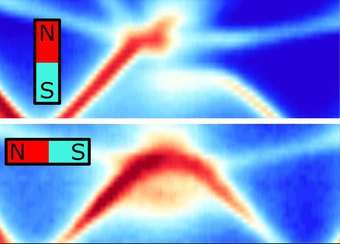Einstein in an iron crystal

Tiny relativistic effects form the basis of the functionalities in modern technology, as exemplified in magnetic hard disks and data storage media. Now for the first time, scientists have directly observed features in an electronic structure that could not be seen previously.
Angle-resolved photoemission spectroscopy has enabled scientists from Forschungszentrum Jülich and LMU Munich to directly visualize the formation of shifts in the band structure (band gaps) of a sample of prototypical magnetic material as a response to the change in direction of a magnetic field.
These gaps in the energy levels of electrons in the iron sample occur in keeping with Einstein's theory of relativity, as electrons flowing through a crystal sample can "sense" the direction of the magnetic field.
In spintronic components that utilize the spin of electrons, these band gaps control the direction of the magnetization and the conductivity. With the help of such methods, the task of designing materials for spintronic applications could soon be made much easier.
More information: E. Młyńczak et al. Fermi Surface Manipulation by External Magnetic Field Demonstrated for a Prototypical Ferromagnet, Physical Review X (2016). DOI: 10.1103/PhysRevX.6.041048
Journal information: Physical Review X
Provided by Forschungszentrum Juelich



















